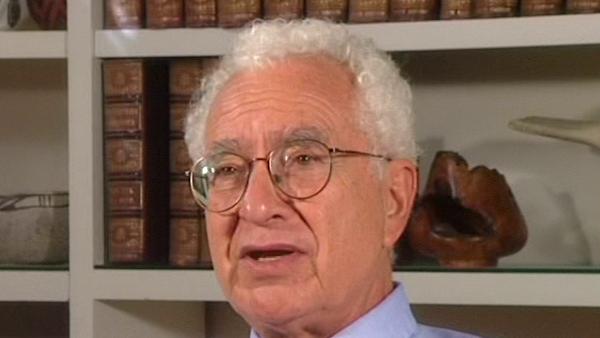NEXT STORY

People at Caltech
RELATED STORIES

NEXT STORY

People at Caltech
RELATED STORIES


|
Views | Duration | |
|---|---|---|---|
| 91. Departmental interaction holds the key | 1048 | 04:02 | |
| 92. The Eightfold Way | 1122 | 02:28 | |
| 93. Worries about the Caltech report | 908 | 03:32 | |
| 94. Re-writing the Eightfold Way paper and publishing in 1962 | 1 | 928 | 03:53 |
| 95. 1962 International Conference at Geneva and the birth of quarks | 1008 | 05:28 | |
| 96. Yuval Ne'eman | 1188 | 04:01 | |
| 97. Working on Regge pole theory | 725 | 04:29 | |
| 98. People at Caltech | 1271 | 00:54 | |
| 99. SU(3) - fundamental triplets | 738 | 01:02 | |
| 100. Working with Goldberger and Low at MIT | 680 | 02:19 |


1961… yes, that was the year that Goldberger and Blankenbecler pointed out that particles of higher and higher angular momentum seemed to lie on Regge trajectories that were quite straight. Again plotted versus mass squared for bosons and versus mass for fermions, and that the odd and even trajectories seemed to be almost degenerate–although they don't have to be by any rigorous principle. I wonder whether–I still wonder, I have wondered all this time and I still wonder—whether the straightness of those trajectories and the accuracy of the first order mass formula for SU(3) aren't somehow related to each other; both are a little bit surprising. In any case, I accepted both field theory and the dispersion theory program of calculating amplitudes on the shell, by means of dispersion relations, generalized unitarity and crossing relations. In fact I had introduced that idea myself back in 1956. So I didn't have any quarrel with the program of Geoffrey Chew and his associates, except for the language that he used to describe it. I thought it was very good to look at self-consistent formulae… self-consistent formulae for scattering amplitudes and so on. Later on I objected to the use of a very, very, very small number of states in these calculations; beating to death with false accuracy one or two states, instead of treating a vast number of states approximately. But that's much later; that's toward the end of the ‘60s.
In the meantime, in 1961, I was intrigued by the Regge trajectories and I worked on them a lot. I worked on the consequences of the complex angular momentum plane analysis for high energy scattering, and high energy reactions in general. And a lot of my associates at Caltech were interested in it. I invited Steven… Steven Frautschi, to come to Caltech, he's still there in fact. But I… I didn't accompany my enthusiasm for this work with a rejection of the concepts of quantum field theory. I was gloomy about finding a correct Lagrangian. I put that off into the distant future, although, as you know, as we discussed before, I did have the idea that both the strong and the weak interactions would be connected somehow with Yang-Mills theory. But the model that I used for abstraction, which I knew was wrong but was a definite Lagrangian field theory, was the one with three fermions of spin a half and a single neutral vector boson. And the three could be neutron, proton and lambda, and then later on of course situation was much…much improved by taking up, down and strange quarks. However the… there was not a direct connection between the work on symmetries and abstraction from quantum field theory models on the one hand, and the work on the complex angular momentum plane on the other. But I did a lot of… a lot of research on the complex angular momentum plane–much of it very technical. For example; while I was in Geneva I worked out the so-called sense and nonsense of poles and all of that kind of thing; things involving more than two particles, things involving complicated… complicated situations that can arise when the spins are taken into account.
New York-born physicist Murray Gell-Mann (1929-2019) was known for his creation of the eightfold way, an ordering system for subatomic particles, comparable to the periodic table. His discovery of the omega-minus particle filled a gap in the system, brought the theory wide acceptance and led to Gell-Mann's winning the Nobel Prize in Physics in 1969.
Title: Working on Regge pole theory
Listeners: Geoffrey West
Geoffrey West is a Staff Member, Fellow, and Program Manager for High Energy Physics at Los Alamos National Laboratory. He is also a member of The Santa Fe Institute. He is a native of England and was educated at Cambridge University (B.A. 1961). He received his Ph.D. from Stanford University in 1966 followed by post-doctoral appointments at Cornell and Harvard Universities. He returned to Stanford as a faculty member in 1970. He left to build and lead the Theoretical High Energy Physics Group at Los Alamos. He has numerous scientific publications including the editing of three books. His primary interest has been in fundamental questions in Physics, especially those concerning the elementary particles and their interactions. His long-term fascination in general scaling phenomena grew out of his work on scaling in quantum chromodynamics and the unification of all forces of nature. In 1996 this evolved into the highly productive collaboration with James Brown and Brian Enquist on the origin of allometric scaling laws in biology and the development of realistic quantitative models that analyse the influence of size on the structural and functional design of organisms.
Tags: Caltech, Geneva, Marvin Goldberger, R Blankenbeckler, Geoffrey Chew
Duration: 4 minutes, 30 seconds
Date story recorded: October 1997
Date story went live: 24 January 2008